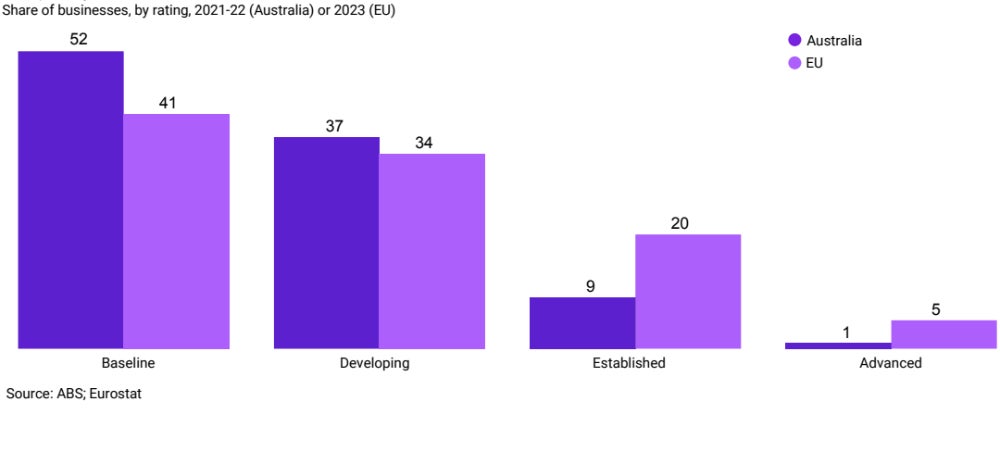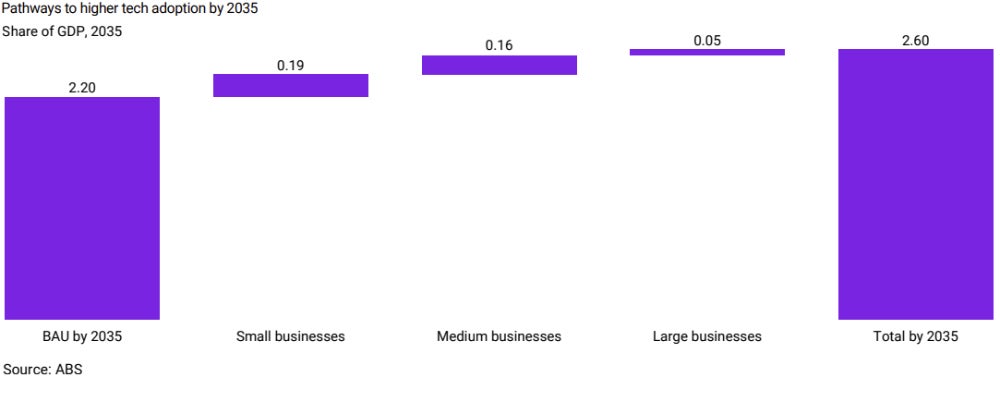A new report by the Tech Council of Australia concluded that Australia’s large, mid-sized, and start-up businesses must increase spending on technology adoption to contribute to an economy-wide push to grow overall tech investment levels and ensure the country does not fall behind the rest of the world.
The report, published in November, argues that Australia should adopt a national technology investment target. It suggests that increasing total tech investment from 3.7% to 4.6% of the country’s GDP could contribute AUD $39 billion in productivity gains by 2035. The boost would require an uplift in both technology adoption investment and tech research and development spending.
Researchers said ramping up spending could enhance economic productivity and keep Australia competitive with global markets.
Technology adoption is part of the pathway to productivity
The Tech Council reported that Australian businesses currently invest $90 billion in technology adoption — equivalent to 2.2% of GDP, or approximately $2,100 per capita. While this figure has risen from $1,700 per capita in 2016-17, the share of GDP has remained unchanged.
According to the report, investing in technology adoption involves acquiring technology that is new to the business but not necessarily to the industry, country, or rest of the world. This distinguishes adoption spending from R&D technology investment, which involves developing entirely new technology.
The Tech Council argues at least a 0.4% GDP rise in tech adoption investment across large, medium, and small businesses, bringing the total to 2.6% of GDP in 2035. A 0.7% rise in R&D spending would bring tech investment spending to 4.6% of GDP — well ahead of a currently projected 3.5%.
Researchers found that if Australia raises total technology investment even higher to 6.9% of GDP, $167 billion in productivity gains could be unlocked by 2035.
“Australians enjoy some of the highest living standards in the world,” Tech Council’s CEO Damian Kassabgi said in a press release. “To ensure we can keep growing, we need to see an uplift in productivity growth.”
He added: “Australia’s productivity growth has been declining for some time, which is one of our most pressing economic challenges. Achieving the level of growth we need to turn this around and see our economy thrive requires greater tech development and adoption.”
Australia lagging in business technology adoption
The report noted that Australian businesses lag behind the European Union in tech adoption.
Australia and the E.U. compare their respective technology adoption levels using a Digital Intensity Index, which measures factors including digital skills, cybersecurity, digital business management, digital technology and infrastructure, and e-commerce and online presence.
Australian businesses cluster more around the bottom rungs of the rating system. Just over half of all Australian businesses have a “baseline” level of tech use, compared with 41% of businesses in the E.U. Only 10% of Australian businesses were classified as either “established” or “advanced,” compared with 25% of firms in the E.U.

This low figure comes despite tech adoption having practical benefits. Research from the Office of Innovation & Science Australia and AlphaBeta showed that the Australian Stock Exchange’s top 200 firms actively investing in tech adoption and R&D between 2005 and 2016 were more likely to survive and grow than other firms on the index that prioritised paying out dividends.
A survey conducted by Ai Group in 2024 found that Australian businesses are addressing their tech adoption challenges. Eighty-four percent of businesses surveyed were found to be actively adopting new tech, including 100% of large businesses, 82% of medium-sized businesses, and 63% of small businesses.
How much tech adoption is required across Australian businesses?
The Tech Council is counting on increased adoption investment from large, medium, and small businesses. Given the current tech adoption levels shown in the E.U. comparison, researchers estimated that:
- Small businesses could contribute 0.19% of GDP in tech adoption investment by 2035 through more of them (12%) moving from a “baseline” status of digital intensity into a “developing” category.
- If a larger number (17%) of medium-sized businesses made the step from “developing” to “established,” helped by scaling innovative small businesses up to this size, they could add 0.16% to the GDP.
- An additional 0.05% of GDP could be gained from large businesses if 7% of them move from “established” to “advanced.” This would see 5% of local businesses labeled as “advanced.”

Economy-wide executive education could boost investment
The Tech Council recommended Australia examine opportunities to create technology industry-led executive education programs for all types of businesses in the economy. The education programs could focus on opportunities for businesses to adopt technology and manage technology risk.
“Managerial skills have been found to have a significant impact on productivity, partly through the role that managers have in facilitating innovation and harnessing the benefits of technologies,” the report said. Recent Gartner research found CIOs have more success when they uplift CXOs across businesses.
Researchers also suggested that these programs should be established as “vendor-agnostic executive education programs,” avoiding them being associated with particular vested technology interests. This would encourage wider uptake in economy-wide tech upskilling to support future investment.
“Tech investment enables companies to commercialise their research and create new business models, making our economy more productive and resilient,” Kassabgi said. “There are also practical benefits to increased tech adoption, which can accelerate the growth of both small and large businesses.”

